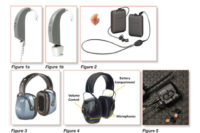Noise + chemical exposure can cause devastating damage

A damaging duo
It turns out that many common industrial chemicals are ototoxic (poisonous to the ears) and as damaging to employees’ hearing as the industrial noise to which they are often exposed. But exposure to noise and chemicals at the same time can be positively devastating to hearing. That’s because their effects are often synergistic rather than merely additive. In other words, the total damage is greater than the damage caused by the sum of the parts.
For example, researchers studying the effects of noise on industrial workers found a higher incidence of hearing loss in workers exposed to lower levels of noise than workers in an area where the noise levels were higher1. However, the workers exposed to the lower noise levels were also exposed to industrial solvents concurrently with the noise, and that made all the difference in the findings! The noise and chemical exposure together accelerated the rate of hearing loss.
Exposure to some chemicals by themselves can cause hearing loss. The worst culprits seem to be organic solvents such as benzene, toluene, xylene and styrene. Nearly all of these, while harmful to hearing on their own, are synergistic with noise exposure. Not only do they contribute to toxic stress in the inner ear, where hearing loss often first occurs, but they can also degrade the function of neural circuits in the brain’s auditory pathways. This neural damage can cause a type of hearing loss that even hearing aids cannot help. And the neural damage is not confined to hearing. Other sensory inputs (vision or smell, for example), cognitive function and motor coordination may all be impaired to a greater or lesser degree, both temporarily and permanently.
There is also evidence of hair cell death in the inner ear from phosphate-based chemicals used in farming, gardening and industrialized agriculture. Some non-benzene carbon compounds, like carbon disulfide and carbon monoxide, also have a profound impact on hearing, as do certain metals known to affect the nervous system. Included among these are the vapors and dusts of lead, mercury, manganese and arsenic.
Far-reaching effects
None of the chemicals, minerals or solvents mentioned so far in this article are necessarily rare or exotic, and this list is not all-inclusive. Ototoxic compounds are rampant and common to a multitude of processes across a wide variety of industries2.
Whereas hearing loss resulting from noise exposure is often confined to a narrow range of pitches — usually the higher frequencies — damage from toxic chemicals can affect hearing anywhere across the frequency range. The inner ear also has the primary responsibility for helping us maintain our balance. Ototoxic compounds can affect all of the inner ear structures — not just the hearing part, but the balance organs too — putting a person at risk for not only hearing loss and tinnitus (ringing in the ears), but for dizziness and vertigo (a spinning sensation) as well.
Combined protection
The point of all this is that wearing a respirator to minimize the inhalation of chemicals, while a good thing in general, is as important as wearing hearing protection when it comes to working with the materials previously mentioned. Because of the synergistic effect of many chemicals with noise, wearing a respirator and hearing protection together should be your first-line defense against hearing loss whenever chemicals are used in an industrial environment.
In fact, even if noise levels alone do not seem loud enough to cause hearing damage (e.g., < 80 dB SPL), the synergy with chemicals makes hearing loss more likely with lower levels of noise exposure. It is therefore good practice to recommend hearing protection even when noise is just below the action level in any environment where chemicals are being used, especially when the use of a respirator is required. Reflecting this more holistic approach to hearing conservation, the United States Army has set the example to be followed by requiring any personnel exposed to known or suspected ototoxins to be enrolled in the Army’s hearing conservation program3, whether or not they are also exposed to noise. Employees exposed to even marginal noise levels together with ototoxins should certainly be considered for inclusion in your company’s hearing conservation program.
References
1. Bergstrom, B. & Nystrom, B. (1986). Development of hearing loss during long-term exposure to occupational noise. A 20-year follow-up study. Scandinavian Audiology, 15, 227-234.
2. Bauman, N.G. (2003). Ototoxic Drugs Exposed. Stewartstown, PA: Guidepost Publications, 533-604.
3. United States Army (10 December 1998). Pamphlet 40-501: Hearing Conservation Program. Washington, D.C.: Department of the Army.
Looking for a reprint of this article?
From high-res PDFs to custom plaques, order your copy today!





